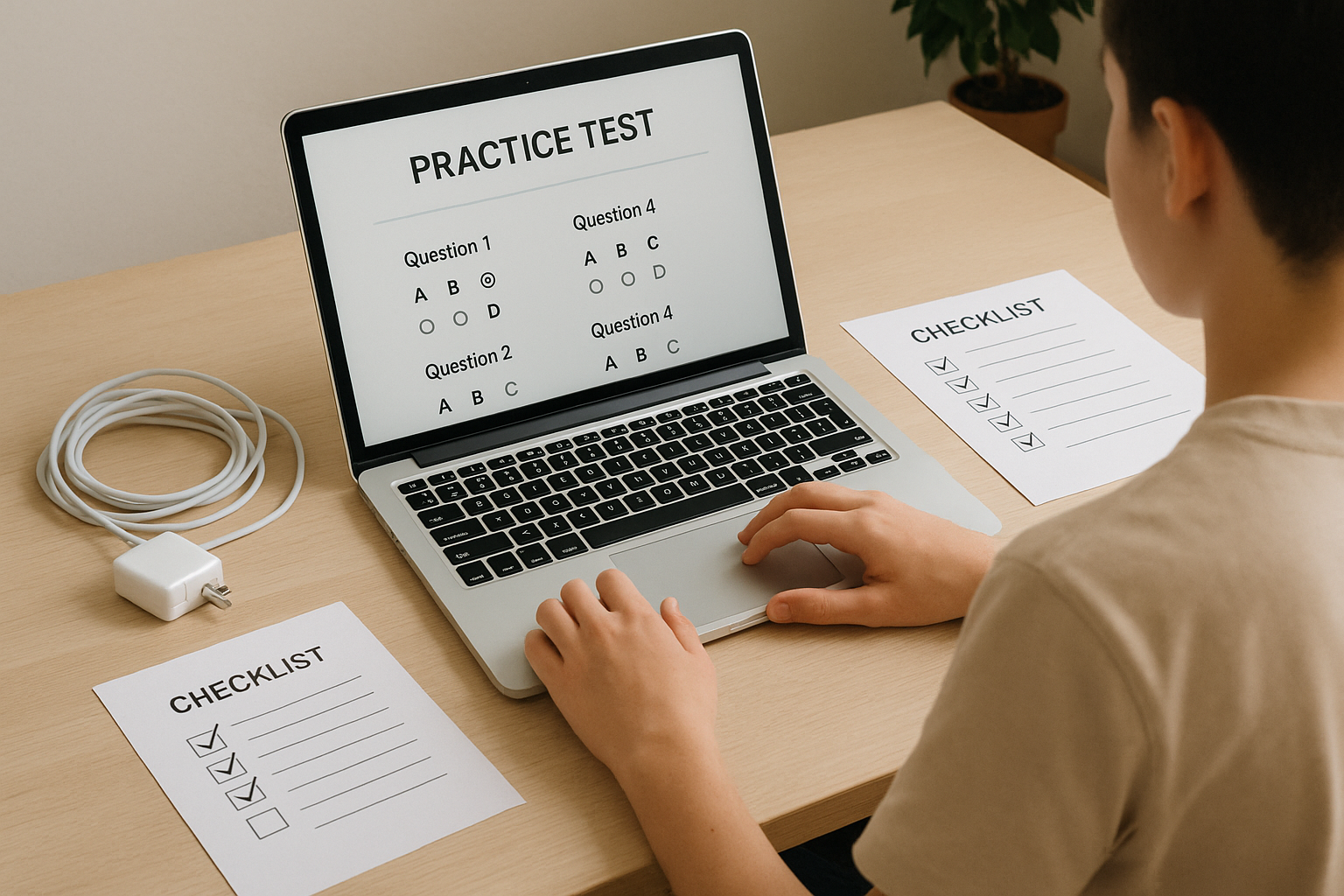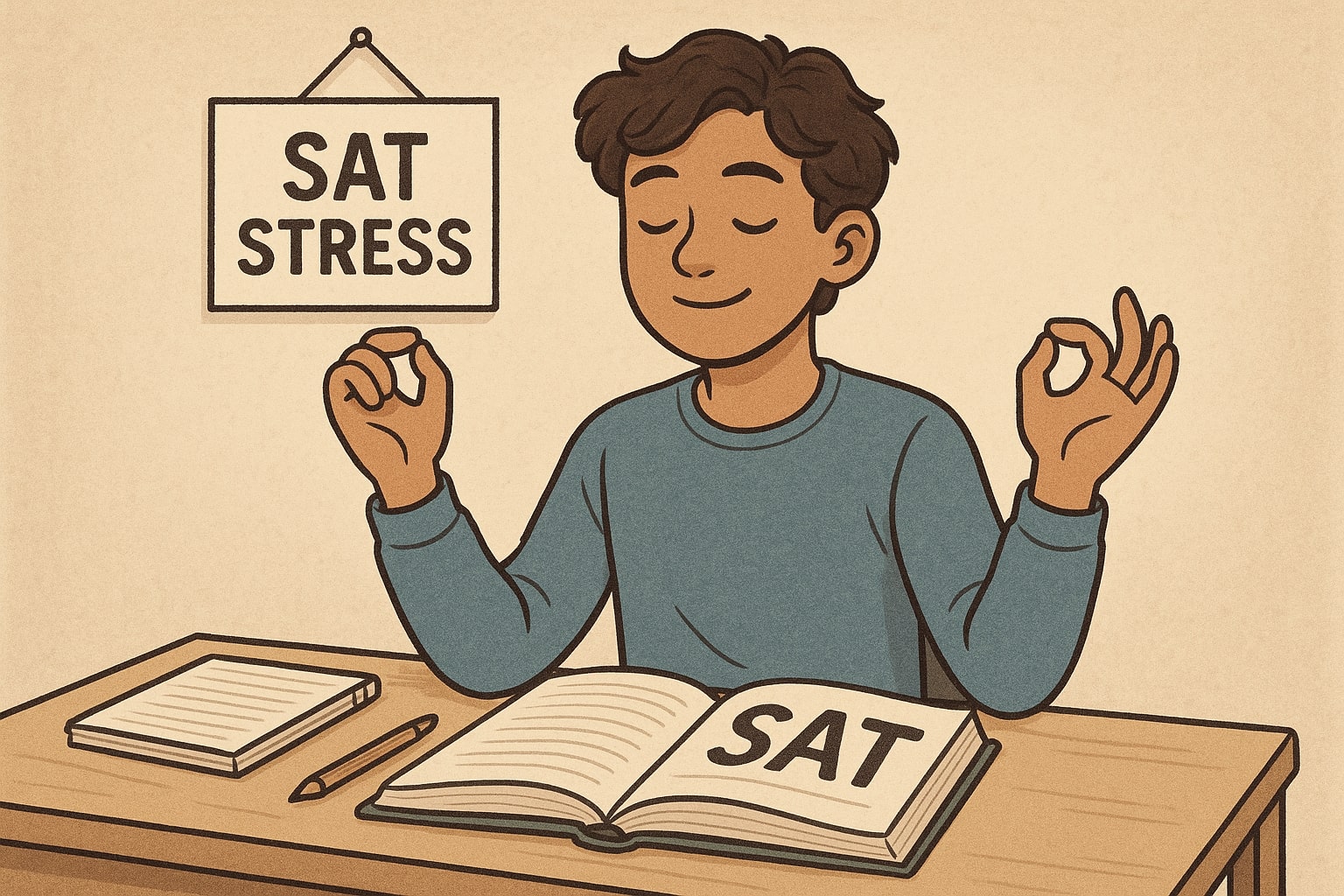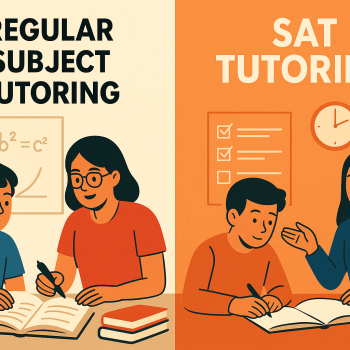Why SAT Prep Stress Shows Up — and Why That’s Okay
If your stomach drops every time you open a practice test or you find your mind racing the night before a test window, you are not alone. Stress around the Digital SAT is a natural reaction to high stakes, a busy schedule, and the desire to do your best. Recognizing stress as a normal signal — not a flaw — is the first step to turning it into fuel. Instead of trying to eliminate stress entirely (impossible and unnecessary), the goal is to manage it so it helps rather than harms your performance.
What stress feels like and what it does to the brain
Stress can feel physical (racing heart, sweaty palms), mental (distracting thoughts, blanking), or behavioral (procrastination, perfectionism). On test day, mild stress can sharpen focus. But when stress tips into overwhelm, working memory and retrieval—the exact skills you need for complex reading and math problems—can suffer. The good news: simple, repeatable strategies can move you back into that optimal zone where stress helps concentration and endurance.
Build a Prep Routine That Reduces Anxiety
Consistency is calming. A routine signals your brain that you have a plan, and a plan reduces the “unknown” — a big driver of anxiety. Design a prep routine that balances practice, review, and life.
Weekly structure: practice + review + reset
- Practice: One or two focused practice sessions per week with full-length, timed sections on Bluebook or official practice formats.
- Review: After each practice, spend 30–60 minutes reviewing mistakes and writing down one specific lesson learned (e.g., “read questions before passages in Data Interpretation”).
- Reset: Plan one low-stakes day for recovery — no SAT study, just exercise, hobbies, or rest.
Small rituals matter: a 5-minute warm-up before every practice (breathing, light stretching, or a short math warm-up) can cut stress and improve consistency.
Daily micro-habits that lower stress
- Start with a 10–15 minute focused block: 25 minutes of study followed by a 5–10 minute break.
- Track progress visually: checklist or habit app shows momentum and reduces worry about “not doing enough.”
- End with a short reflection: note one improvement and one thing to try next time.
Study Smart: Quality Beats Quantity
Long, unfocused hours often increase anxiety without improving scores. Swap marathon sessions for targeted practice and intentional review.
Active review beats passive review
Instead of re-reading notes, do the following:
- Re-do missed problems under timed conditions, then compare strategies.
- Create a short summary card for each recurring error (e.g., punctuation rules, function transformations, evidence-based reading traps).
- Teach a concept to someone else or explain it out loud — teaching strengthens recall and calms nerves.
Use a diagnostic to guide your plan
Run a practice test to identify your weakest areas, then allocate study time proportionally. If geometry errors cost you time, shift more sessions to focused geometry practice. If reading passages drain stamina, practice shorter timed drills to build endurance.
Practical Test-Day Prep to Reduce Panic
Worry often comes from uncertainty. Clear, practical test-day preparation removes guesswork and frees mental space for performance.
Device readiness and logistics
On the Digital SAT you’ll use the Bluebook testing app. Make sure your device is ready well before test day, and practice using the exact test interface so nothing surprises you on the clock.
| Item | Action | Why it helps |
|---|---|---|
| Bluebook app | Download and complete exam setup 30+ days before test day | Removes last-minute tech panic |
| Chargers & backups | Pack power cord and portable charger | Prevents power-related stress |
| Admission ticket | Save a screenshot or print a copy | Quick access if log-in issues arise |
| Practice setup | Take at least two full practice tests in Bluebook | Builds familiarity and confidence |

Night-before and morning-of checklist
- Night before: finish studying 60–90 minutes before bed, do a relaxing activity, and pack your bag.
- Morning of: eat a balanced breakfast, do a brief review of a single concept you feel good about, and practice 5 minutes of controlled breathing.
Mindset and Cognitive Tools for Anxiety
Stress often lives in stories we tell ourselves: “If I don’t score X, I’ve failed.” Rewriting these stories and using cognitive tools can shrink anxiety quickly.
Reframe pressure into purpose
Translate fear into an action-oriented prompt. Instead of “I’m terrified of failing,” try “I can treat this practice test as feedback on what to fix.” Reframing reduces catastrophic thinking and increases problem-focused coping.
Use brief cognitive exercises
- 5-4-3-2-1 grounding: name 5 things you see, 4 you can touch, 3 you hear, 2 you smell, 1 you taste (or a positive memory). This moves attention away from panic and back into the present.
- Positive retrieval: keep a short list of past failures you overcame (a rough quiz turned into an A after studying). Reminding yourself of resilience counters helplessness.
Mindfulness, Movement, and Sleep — The Triple Pillars
Physical wellness anchors mental performance. Three areas have outsized influence on test-day calm: mindfulness (or focused breath), regular physical activity, and high-quality sleep.
Simple mindfulness you can do anytime
You don’t need long meditations. Try this 3-minute breathing reset:
- Sit comfortably and inhale for 4 counts, hold 2, exhale 6. Repeat 6 times.
- If a thought intrudes, label it (“thinking”) and return to the breath without judging.
Movement that reduces cortisol and sharpens focus
Twenty to thirty minutes of moderate aerobic activity most days — walking, cycling, or a quick HIIT routine — lowers stress hormones and improves sleep. Even a short brisk walk before a study block can reset attention and ease anxiety.
Sleep habits that protect memory
Consolidation happens during sleep. Aim for consistent bed and wake times, avoid screens 30–60 minutes before bed, and treat the week before the SAT as “sleep-sensitive” — prioritize rest over extra late-night cramming.
Nutrition and Small Comforts for Peak Focus
Your brain runs on food and oxygen; small nutritional choices can make a tangible difference in mood and stamina.
Pre-test meals and snacks
- Breakfast: combine protein + complex carbs (e.g., yogurt with oats, peanut butter toast, eggs and whole-grain toast).
- Snacks for breaks: a banana, handful of nuts, or a granola bar provide steady energy without sugar crashes.
- Hydration: sip water throughout the session; dehydration can look like fatigue or irritability.
When Perfectionism Gets in the Way
Perfectionism masquerades as discipline but often leads to paralysis. The SAT is a timed, imperfect measure — aiming for progress rather than perfection keeps momentum going.
Set “good enough” targets
Instead of “I must never miss an algebra II question,” set goals like “I’ll reduce careless errors by one item per section this week.” Concrete, achievable goals lower anxiety and produce consistent improvement.
Batch worry into a “worry time”
If intrusive thoughts arise during study, give yourself 10 minutes later in the day as a scheduled “worry session.” This practice confines anxiety and helps you stay present while studying.
Study Support: When to Get Help and How Sparkl Fits In
Sometimes stress comes from not knowing the best way to study. This is where targeted support can cut weeks off your timeline and reduce anxiety dramatically. Personalized tutoring provides structure, accountability, and skills transfer — not just more hours with practice problems.
What personalized tutoring should offer
- 1-on-1 guidance that adapts to your learning style and pace.
- Tailored study plans focused on your diagnostic gaps.
- Expert tutors who teach strategies for both content and test-taking skills.
- AI-driven insights that identify trends in your mistakes and suggest focused practice.
Sparkl’s personalized tutoring blends these elements: one-on-one instruction, tailored study plans, expert tutors, and AI-driven insights to pinpoint and eliminate your weak spots. Many students find that having an individualized plan and a coach to walk them through progress removes a ton of uncertainty — which, in turn, lowers stress.
Practice under Pressure: Simulate, Then Dilute
The best way to make the real test feel less threatening is to practice under similar conditions — then practice again under slightly easier conditions to build confidence.
Progressive simulation plan
- Week 1–2: Short timed sections (30–60 minutes) to practice pacing and strategies.
- Week 3–4: One full practice test in Bluebook under timed conditions.
- Week 5: One full practice test, then one lighter session focused on confidence-building topics.
After each full test, treat recovery as part of the plan: analyze errors the next day when you are rested, and celebrate small wins — an important part of building a resilient mindset.
Real-World Examples and Quick Wins
Here are short stories and quick strategies that students can borrow and try right away.
Case: The Over-Reviewer
Marisol spent every evening reviewing practice tests word-for-word and felt constantly behind. We suggested a 3-step plan: pick the two most damaging mistake types, make one-page summaries for each, and spend three 20-minute sessions per week on targeted drills. Within a month she regained confidence and reduced her review time, leaving evenings free for rest.
Quick wins you can do today
- Do a 10-minute timed section and then spend 15 minutes reviewing just errors for strategy patterns.
- Swap tonight’s two-hour cram for a 20-minute review + 40 minutes of reading a book you enjoy—better sleep and memory consolidation.
- Practice the 4-2-6 breathing pattern for 3 minutes before a study block to sharpen attention.
When Stress Feels Unmanageable: Signs and Steps
Not all stress is temporary. If symptoms — insistent panic, disrupted sleep for weeks, or avoidance of schoolwork — interfere with daily life, it’s important to act.
Steps to take if stress is overwhelming
- Talk to a counselor or trusted adult about how you’re feeling.
- Break study tasks into tiny steps and ask for help with planning.
- Consider short-term professional support if anxiety is severe.
Remember: asking for help is a strength. Your test score is only one part of your future; your mental health matters more.
Putting It All Together: A Sample 7-Day Stress-Reducing Plan
This plan combines the practices above into a manageable week that builds confidence without burning you out.
| Day | Focus | Actions |
|---|---|---|
| Monday | Diagnostic + Plan | Short diagnostic section; identify top 2 weaknesses; schedule study slots. |
| Tuesday | Targeted Practice | 30–45 min on weakest topic; 10-min breathing before study; 20-min walk after. |
| Wednesday | Timed Work | One timed section in Bluebook; review mistakes; make 1 strategy card per error type. |
| Thursday | Rest + Review | Light review hour; hobby time in the evening; focus on sleep hygiene. |
| Friday | Full Practice | Full practice test; short celebration after finishing; no heavy review the same day. |
| Saturday | Deep Review | Review errors from Friday for 60–90 minutes; plan next week’s targets. |
| Sunday | Recharge | No SAT study; physical activity and social time. |
Note about tutors
If you feel unsure about building or sticking to a plan, a tutor can provide the coaching and accountability you need. Sparkl’s approach—personalized plans, 1-on-1 guidance, and AI-driven insights—can be particularly helpful when you want structure without extra stress.
Final Thoughts: Keep Perspective and Be Kind to Yourself
Preparing for the Digital SAT is a marathon, not a sprint. Progress is often slow and uneven. The most reliable antidote to stress is consistent, intentional practice paired with rest and perspective. When you mix practical device readiness, targeted study, movement, sleep, and calming mental habits, your performance will follow. And if you want help shaping a plan that fits your life, consider one-on-one guidance—coaches can remove uncertainty and turn stress into a managed, motivating force.
Above all: treat yourself like a student who deserves rest, clear plans, and compassion. The SAT is important, but it’s one chapter in a bigger story where your habits, resilience, and curiosity matter far more than a single number.
Quick checklist to take away
- Set a weekly routine: practice, review, reset.
- Do device and logistics prep 30+ days before test day.
- Practice breathing and grounding exercises for quick resets.
- Prioritize sleep, movement, and balanced nutrition.
- Use targeted, active review rather than passive re-reading.
- Consider personalized tutoring for structure and anxiety reduction—Sparkl offers tailored plans and expert coaching to help you stay on track.
Good luck — and remember: calm, consistent work beats frantic perfection. You’ve got this.



















No Comments
Leave a comment Cancel